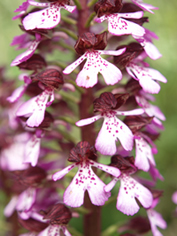UK: Quality not quantity for woodlands
01.12.11
One in six woodland flowers is threatened with extinction and good management is key to reversing the worrying declines in woodland plants and animals say one of the UK's leading plant charities, Plantlife, in their latest report.
"Forestry Recommissioned: bringing England's woodlands back to life", reveals that a lack of management has led to darker woods where plants can't flourish, say Plantlife.
Woodland ownership has dominated the news in recent years, but that isn't the crux of the problem. Of much more importance is what we do with them. "Over the last 50 years, England's woodlands have become increasingly dark, overgrown, and silent," said Victoria Chester, Plantlife's chief executive, as woodlands have fallen out of management.
One startling figure (on page 11) perhaps exemplifies this point more than any other:
"In 1947, 49% of broadleaved woodland was classed as coppice or scrub and just 51% as high forest. By 2002, high forest represented a staggering 97% of the broadleaved resource."
The report goes on to say: "Most woodland plants are not shade tolerant and prefer lighter conditions. This not only applies to woodland flowers but also to lichens, mosses and liverworts."
"Plantlife has a vision which will bring them back to life," Chester continues. And the answers turn out to be relatively straightforward: a return to coppicing, pollarding, and grazing. "The traditional practices of coppicing and pollarding open up the woodland canopy, so letting in light and creating conditions suitable for the majority of woodland plants. Actively managed coppice is the lowlands of south and eastern Britain is especially valued for its displays of spring flowers such as wood anenome, primrose, early purple orchid, and wood violet," says the report.
Coppicing at Plantlife's Ranscombe Farm Reserve in Kent © Sue Nottingham
 However, another problem facing woodlands is invisible. Woodland plants, like their grassland cousins, thrive in landscapes with low nutrient levels. But between 93 and 98 per cent of British woodland is "growing under excessive nitrogen levels, " says the report, and in areas of high nutrient levels, species such as nettle and bramble out-compete other species, reducing overall diversity. Plantlife claim that by restoring traditional woodland management techniques, over time, the nutrient load will reduce.
However, another problem facing woodlands is invisible. Woodland plants, like their grassland cousins, thrive in landscapes with low nutrient levels. But between 93 and 98 per cent of British woodland is "growing under excessive nitrogen levels, " says the report, and in areas of high nutrient levels, species such as nettle and bramble out-compete other species, reducing overall diversity. Plantlife claim that by restoring traditional woodland management techniques, over time, the nutrient load will reduce.
Lady orchid - one of the many woodland plants threatened with extinction © Andrew Gagg
Plantlife's message is clear. By returning to traditional management techniques, and getting value out of our woodlands once again, people and wildlife will benefit.
Related links:
25.10.10
![]() The largest shake-up of UK land ownership in recent times looms as plans to sell off more 150,000 hectares of woodland and forestry are drawn up by the government.
The largest shake-up of UK land ownership in recent times looms as plans to sell off more 150,000 hectares of woodland and forestry are drawn up by the government.
UK: New book for woodland managers
23.09.10
![]() A handbook designed to help the owners and managers of native broadleaved woodland get the most from their trees has been published by the Forestry Commission.
A handbook designed to help the owners and managers of native broadleaved woodland get the most from their trees has been published by the Forestry Commission.
28.05.10
![]() Plantlife, one of the UK's most important plant conservation charities, has received a face-lift from non-profit branding experts Spencer du Bois.
Plantlife, one of the UK's most important plant conservation charities, has received a face-lift from non-profit branding experts Spencer du Bois.
UK: Ghost Orchid (slight return)
09.03.10
![]() News emerged yesterday that a Ghost Orchid (Epipogium aphyllum) was found in the UK in 2009 (link to Guardian story).
News emerged yesterday that a Ghost Orchid (Epipogium aphyllum) was found in the UK in 2009 (link to Guardian story).
UK: A comeback 60 years in the making
06.11.09
 Plantlife tell us of new hope for a rare plant - lost since World War II. Starved Wood-sedge (Carex depauperata) – a delicate grass-like plant with tall flowering stems - is one of Britain’s rarest plants, currently found in only two locations in Surrey and Somerset.
Plantlife tell us of new hope for a rare plant - lost since World War II. Starved Wood-sedge (Carex depauperata) – a delicate grass-like plant with tall flowering stems - is one of Britain’s rarest plants, currently found in only two locations in Surrey and Somerset.
UK: Where have all the Ghost Orchids gone?
15.10.09
![]() The Ghost Orchid is an apt name for a plant that hasn’t been seen for such a long time, but sadly it's the latest addition to the UK extinct list.
The Ghost Orchid is an apt name for a plant that hasn’t been seen for such a long time, but sadly it's the latest addition to the UK extinct list.